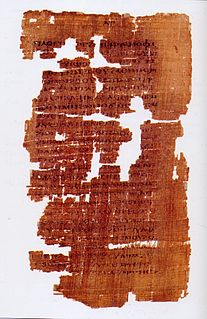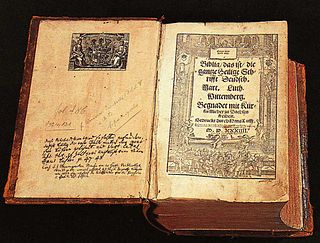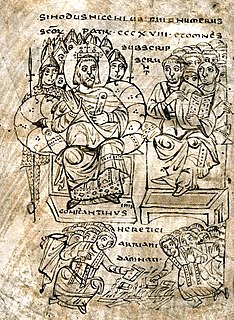Related Research Articles

The Bible is a collection of religious texts or scriptures sacred in Christianity, Judaism, Samaritanism, and many other religions. The Bible is an anthology—a compilation of texts of a variety of forms—originally written in Hebrew, Aramaic, and Koine Greek. These texts include instructions, stories, poetry, and prophecies, among other genres. The collection of materials that are accepted as part of the Bible by a particular religious tradition or community is called a biblical canon. Believers in the Bible generally consider it to be a product of divine inspiration, while understanding what that means and interpreting the text in differing, various ways.

The New Testament (NT) is the second division of the Christian biblical canon. It discusses the teachings and person of Jesus, as well as events in first-century Christianity. The New Testament's background, the first division of the Christian Bible, is called the Old Testament, which is based primarily upon the Hebrew Bible; together they are regarded as sacred scripture by Christians.

The Old Testament is the first division of the Christian biblical canon, which is based primarily upon the 24 books of the Hebrew Bible or Tanakh, a collection of ancient religious Hebrew writings by the Israelites. The second division of Christian Bibles is the New Testament, written in the Koine Greek language.

Montanism, known by its adherents as the New Prophecy, was an early Christian movement of the late 2nd century, later referred to by the name of its founder, Montanus. Montanism held views about the basic tenets of Christian theology similar to those of the wider Christian Church, but it was labelled a heresy for its belief in new prophetic revelations. The prophetic movement called for a reliance on the spontaneity of the Holy Spirit and a more conservative personal ethic. Parallels have been drawn between Montanism and modern-day movements such as Pentecostalism and the Charismatic movement.

The Muratorian fragment, also known as the Muratorian Canon, is a copy of perhaps the oldest known list of most of the books of the New Testament. The fragment, consisting of 85 lines, is a 7th-century Latin manuscript bound in a 7th- or 8th-century codex from the library of Columbanus's monastery at Bobbio Abbey; it contains features suggesting it is a translation from a Greek original written about 170 or as late as the 4th century. Both the degraded condition of the manuscript and the poor Latin in which it was written have made it difficult to translate. The beginning of the fragment is missing, and it ends abruptly. The fragment consists of all that remains of a section of a list of all the works that were accepted as canonical by the churches known to its original compiler.

The Gospel of the Hebrews, or Gospel according to the Hebrews, was a Jewish–Christian gospel. The text of the gospel is lost with only fragments of it surviving as brief quotations by the early Church Fathers and in apocryphal writings. The fragments contain traditions of Jesus' pre-existence, incarnation, baptism, and probable temptation, along with some of his sayings. Distinctive features include a Christology characterized by the belief that the Holy Spirit is Jesus' Divine Mother and a first resurrection appearance to James, the brother of Jesus, showing a high regard for James as the leader of the Jewish Christian church in Jerusalem. It was probably composed in Greek in the first decades of the 2nd century, and is believed to have been used by Greek-speaking Jewish Christians in Egypt during that century.

The Council of Jerusalem or Apostolic Council was held in Jerusalem around AD 50. It is unique among the ancient pre-ecumenical councils in that it is considered by Catholics and Eastern Orthodox to be a prototype and forerunner of the later ecumenical councils and a key part of Christian ethics. The council decided that Gentile converts to Christianity were not obligated to keep most of the fasts, and other specific rituals, including the rules concerning circumcision of males. The Council did, however, retain the prohibitions on eating blood, meat containing blood, and meat of animals that were strangled, and on fornication and idolatry, sometimes referred to as the Apostolic Decree or Jerusalem Quadrilateral. The purpose and origin of these four prohibitions is debated.

The Pauline epistles are the fourteen books in the New Testament traditionally attributed to Paul the Apostle.

The Gospel of Marcion, called by its adherents the Gospel of the Lord, was a text used by the mid-2nd-century Christian teacher Marcion of Sinope to the exclusion of the other gospels. The majority of scholars agree the gospel was an edited version of the Gospel of Luke.
Bruce Manning Metzger was an American biblical scholar, Bible translator and textual critic who was a longtime professor at Princeton Theological Seminary and Bible editor who served on the board of the American Bible Society and United Bible Societies. He was a scholar of Greek, New Testament, and New Testament textual criticism, and wrote prolifically on these subjects. Metzger was one of the most influential New Testament scholars of the 20th century. He was elected to the American Philosophical Society in 1986.
Jason David BeDuhn is a historian of religion and culture, currently Professor of Religious Studies at Northern Arizona University.

The Old Testament is the first section of the two-part Christian biblical canon; the second section is the New Testament. The Old Testament includes the books of the Hebrew Bible (Tanakh) or protocanon, and in various Christian denominations also includes deuterocanonical books. Orthodox Christians, Catholics and Protestants use different canons, which differ with respect to the texts that are included in the Old Testament.
The Epistle to the Alexandrians is a pseudepigraphical Epistle attributed to Paul the Apostle that is mentioned in the Muratorian fragment, one of the earliest lists of the canonical texts of the New Testament. The anonymous author of the Muratorian canon considered this epistle as spurious, along with the Epistle to the Laodiceans, and both of them are stated to have been "forged in Paul's name to [further] the heresy of Marcion." Its text has been lost and nothing is known about its content.
The Canon of Trent is the list of books officially considered canonical at the Roman Catholic Council of Trent. A decree, the De Canonicis Scripturis, from the Council's fourth session, issued an anathema on dissenters of the books affirmed in Trent. The Council confirmed an identical list already locally approved in 1442 by the Council of Florence, which had existed in the earliest canonical lists from the synods of Carthage and Rome in the fourth century.

Syriac is a dialect of Aramaic. Portions of the Old Testament were written in Aramaic and there are Aramaic phrases in the New Testament. Syriac translations of the New Testament were among the first and date from the 2nd century. The whole Bible was translated by the 5th century. Besides Syriac, there are Bible translations into other Aramaic dialects.

Luther's canon is the biblical canon attributed to Martin Luther, which has influenced Protestants since the 16th-century Protestant Reformation. While the Lutheran Confessions specifically did not define a canon, it is widely regarded as the canon of the Lutheran Church. It differs from the 1546 Roman Catholic canon of the Council of Trent in that it rejects the deuterocanonical books and questions the seven New Testament books, called "Luther's Antilegomena", four of which are still ordered last in German-language Luther Bibles to this day.
Melito's canon is the biblical canon attributed to Melito of Sardis, one of the early Church Fathers of the 2nd century.

A biblical canon is a set of texts which a particular Jewish or Christian religious community regards as part of the Bible.

The canon of the New Testament is the set of books many modern Christians regard as divinely inspired and constituting the New Testament of the Christian Bible. For historical Christians, canonization was based on whether the material was from authors socially approximate to the apostles For most, it is an agreed-upon list of 27 books that includes the canonical Gospels, Acts, letters attributed to various apostles, and Revelation, though there are many textual variations. The books of the canon of the New Testament were written before 120 AD. Although the list of what books constituted the canon differed among the hundreds of churches in antiquity, according to ancient church historian Eusebius there was a consensus that the same 27 books constituting the canon today were the same 27 books generally recognized in the first century. For the Orthodox, the recognition of these writings as authoritative was formalized in the Second Council of Trullan of 692. The Catholic Church provided a conciliar definition of its biblical canon in 382 at the (local) Council of Rome as well as at the Council of Trent of 1545, reaffirming the Canons of Florence of 1442 and North African Councils of 393–419. For the Church of England, it was made dogmatic on the Thirty-Nine Articles of 1563; for Calvinism, on the Westminster Confession of Faith of 1647.

Traditionally in Christianity, orthodoxy and heresy have been viewed in relation to the "orthodoxy" as an authentic lineage of tradition. Other forms of Christianity were viewed as deviant streams of thought and therefore "heterodox", or heretical. This view was challenged by the publication of Walter Bauer's Rechtgläubigkeit und Ketzerei im ältesten Christentum in 1934. Bauer endeavored to rethink Early Christianity historically, independent from the views of the current church. He stated that the 2nd-century church was very diverse and included many "heretical" groups that had an equal claim to apostolic tradition. Bauer interpreted the struggle between the orthodox and heterodox to be the "mainstream" Church of Rome struggling to attain dominance. He presented Edessa and Egypt as places where the "orthodoxy" of Rome had little influence during the 2nd century. As he saw it, the theological thought of the "Orient" at the time would later be labeled "heresy". The response by modern scholars has been mixed. Some scholars clearly support Bauer's conclusions and others express concerns about his "attacking [of] orthodox sources with inquisitional zeal and exploiting to a nearly absurd extent the argument from silence." However, modern scholars have critiqued and updated Bauer's model.
References
- ↑ Wright, David F. (1976). "Why Were the Montanists Condemned?". Themelios. 2 (1).
- 1 2 Prophets Male and Female: Gender and Prophecy in the Hebrew Bible, the Eastern Mediterranean, and the. SBL Press. 2013-06-05. ISBN 978-1-58983-777-5.
- ↑ Metzger, Bruce M. (1997-03-07). The Canon of the New Testament: Its Origin, Development, and Significance. Clarendon Press. ISBN 978-0-19-156860-2.
- ↑ Metzger, Bruce M. (1997-03-07). The Canon of the New Testament: Its Origin, Development, and Significance. Clarendon Press. ISBN 978-0-19-156860-2.
